Uncategorized
Teen people of color are finding, and building, their own spaces in Jewish life
This article was produced as part of JTA’s Teen Journalism Fellowship, a program that works with Jewish teens around the world to report on issues that affect their lives.
(JTA) — As a young Black Jewish adoptee, Lindsey Newman felt close to the Jewish community on the Upper West Side of Manhattan, where she grew up. Then adolescence hit and she started to feel like an outsider, struggling to find acceptance and independence at her synagogue.
It wasn’t until the end of high school that she began connecting on social media to organizations like the Jewish Multiracial Network and Be’chol Lashon to build her own connection to other Jews of color and find a sense of belonging.
Now, as the director of community engagement at Be’chol Lashon, an organization that supports Jewish diversity, Newman works to make sure other Jews of color like her feel welcomed and included in Judaism.
“Diversity is one of Judaism’s greatest assets,” said Newman. “When we even unintentionally leave out or marginalize parts of our community, we all lose.”
Around 17% of American Jews identify as nonwhite, according to a 2021 Pew Research Center report. But, as the Jews of Color Initiative found, only 18% out of the 1,118 surveyed belong to a synagogue — compared, according to another Pew study, to the 35% of all U.S. Jews who are synagogue members or have someone in their household who is a member. To address this gap, organizations and synagogues are developing programs to help Jewish teens of color feel at home.
For BBYO member Micah Pierandri, 17, the experience of being part of her local chapter in Tulsa, Oklahoma has been great. For example, she loved meeting Olympic gymnast Gabby Douglas at the youth group’s International Convention. However, Pierandri, who is African American, wanted to connect more with JOCs, so she started the Members of Color Alliance through BBYO late last fall.
The club came about after she was called slurs at a BBYO summer camp in Pennsylvania by, according to Pierandri, participants who were “a mix of people of color and not.” BBYO did not respond to requests about the incident. Pierandri said the staff handled it well enough, but that she wanted to build on her experience. “I knew that if someone wasn’t going to stand up for other MOCs within BBYO I knew I could make that change,” she said. “I fought and fought until I did and here we are.”
The 12-member group provides a space specifically for teens of color to come together and connect with others similar to them, something Pierandri didn’t see existing before. MOCA members usually meet online through Zoom to discuss racial justice, learn from speakers, play games and provide cultural exchanges. Sometimes, members just get to chill with each other. “While the club is more racial justice-based I try my best to make sure it’s still fun and everyone has an amazing time,” said Pierandri.
Pierandri was able to form MOCA through On Demand, a virtual platform of BBYO. Late last year, the youth group released a new form for BBYO members to create any type of club that they desired. “Almost within less than 24 hours I had texts from all sorts of BBYO staff telling me they have my back for MOCA and want to help me make it a reality,” Pierandri said.
One MOCA member, Morgan Rodriguez, 16, felt turned off by other organizations’ JOC groups until she found the club within BBYO. As a Latino Jew, she felt she didn’t fit the stereotype of what a JOC should look like. “It was almost disheartening to find out that an organization wouldn’t want somebody because they’re mixed [race],” said Rodriguez, who lives in Delray Beach, Florida and is a mix of Ashkenazi and Ethiopian Jewish, Liberian, Cuban, Irish and Dutch ancestry.
Fortunately, Rodriguez sees the conversation changing, something she credits to social media. As a bonus, being able to see Jews who looked like her online made her feel more comfortable in her Jewishness.
The LUNAR Collective is trying to create this same space for teen Asian American Jews. The Bay Area-based group, which started as a film project, holds events to encourage pride in Asian Americans’ identities.
Rabbi Mira Rivera, rabbi-in-residence for LUNAR and the first Philipina rabbi to be ordained at the Conservative Jewish Theological Seminary, said that when she joined synagogues after she was married, she struggled to find others to unite with. “The people I saw who looked like me were the ones I wasn’t supposed to talk to because they didn’t want to be outed [as converts] or they were the caregivers of members,” she said.
Other institutions have introduced initiatives over the past few years to engage Jewish teens of color in their community.
Be’chol Lashon, founded in San Francisco, started a Teen Tzedek fellowship during COVID. It provides mentorship for teens who are ethnically diverse, a multicultural summer camp and an online publication, Jewish&, that allows people of all ages to express their beliefs and stories through personal articles.
“Many young JOCS not only wanted and needed a peer network of other JOCs that looked like them, that had similar experiences, but also wanted and needed role models that reflected their experience,” said Be’chol Lashon’s Newman about Camp Be’chol Lashon.
The North American Federation of Temple Youth plans to create a fellowship for Reform Jewish teens of color, according to Kelly Whitehead, a rabbinic intern there.
This would be a welcome step for NFTY member Ben Smulewitz, 15, a Jewish teen of color living in San Rafael, California. “I’ve found a whole new Jewish community, and I’ve really enjoyed finding those people because there’s not that many of us out here,” said Smulewitz. “It’s nice to have Jewish friends because then you can relate on different levels about things.”
Rabbi Mira Rivera, center, said that when she joined synagogues after she was married, she struggled to find other Jews of color to unite with. (Courtesy of Ammud)
Last summer, Camp Newman in Virginia Beach organized a mediation after a few white teens made a game out of trying to stick pencils in a Black camper’s hair without her noticing, according to Smulewitz. JOCs shared their personal stories, which included programming that he helped lead.
When asked about the incident, URJ’s Executive Director of Strategic Innovation and Program, Michelle Shapiro Abraham, declined to disclose any specific information. In an email she wrote that: “We understand and embrace the diversity of our Jewish community and are very focused on making sure everyone feels like they belong.”
Another thing that helped Smulewitz feel more comfortable at NFTY was the affinity groups he joined at L’Taken, a social justice seminar held in Washington DC. It was, however, to acknowledge that you are a “minority within the minority.”
“It makes me sad to know that there are people that are scared to come out and say that they are a Jew of color instead of just blending in with everyone else.”
Synagogues are also striving to include teen JOCs in their programming Although Romemu and Central Synagogue, both in New York, don’t currently have programming specifically tailored for teens, they are making efforts to expand and include more teens of color.
Romemu is working with IKAR, a synagogue in Los Angeles that helps organizations and synagogues introduce more strategies to enhance their inclusivity.
According to Susan Brooks, human resources and operations manager at IKAR, “a lot of Jews of color are not affiliated with synagogues or Jewish organizations because in the past, they have not necessarily felt welcome,” making it difficult to get a good turnout. Being welcoming is the first step, Brooks said, to attracting a diverse group.
Gulienne Rollins-Rishon, racial justice specialist at the United Synagogue of Conservative Judaism, said that within programming, JOCs sometimes “end up feeling like collectors’ items,” because they are often treated as tokens by organizations that want to demonstrate their diversity: “Like, how many Jews of color [do] we have here?” Rollins-Rishon said that people, especially teens, need to be able to define and own their identities.
“We need to create not only the space for Jewish teens of color to come and see that they’re being represented and reflected, but also [for them to think], I’m so glad that’s there because it means that I know I’m welcome here and I’m included here,” she said.
As a Black Jew, Rollins-Rishon has dealt with jarring experiences, such as when she was refused access to a Hanukkah party during her freshman year of college because the Hillel liaisons told her the room was reserved. They “literally tried to turn me away,” she said.
Now as an adult, her mission is for this not to happen to others. She said, “Now it’s my torch to carry to make sure that kids don’t have to run up against that wall as much.”
—
The post Teen people of color are finding, and building, their own spaces in Jewish life appeared first on Jewish Telegraphic Agency.
Uncategorized
How the Global Religious Landscape Changed from 2010 to 2020

Muslims grew fastest; Christians lagged behind global population increase
• Christians are the world’s largest religious group, at 28.8% of the global population. They are a majority everywhere except the Asia-Pacific and Middle East-North Africa regions. Sub-Saharan Africa has surpassed Europe in having the largest number of Christians. But Christians are shrinking as a share of the global population, as millions of Christians “switch” out of religion to become religiously unaffiliated.
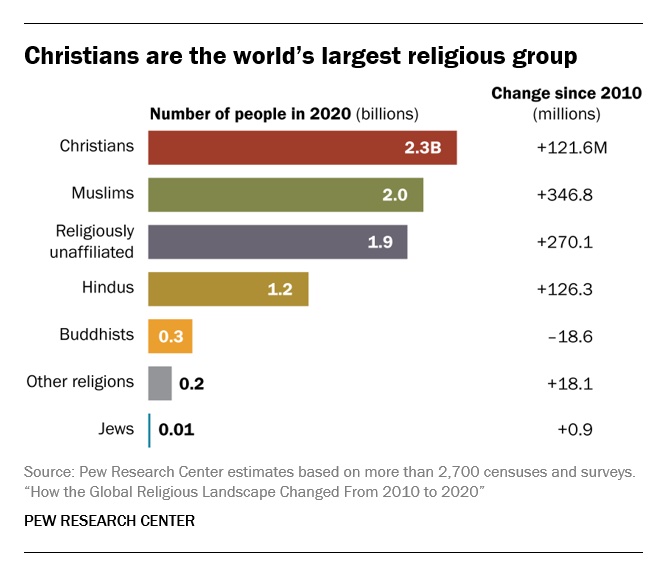
• Muslims are the world’s second-largest religious group (25.6% of the world’s population) and the fastest-growing major religion, largely due to Muslims’ relatively young age structure and high fertility rate. They make up the vast majority of the population in the Middle East-North Africa region. In all other regions, Muslims are a religious minority, including in the Asia-Pacific region (which is home to the greatest number of Muslims).
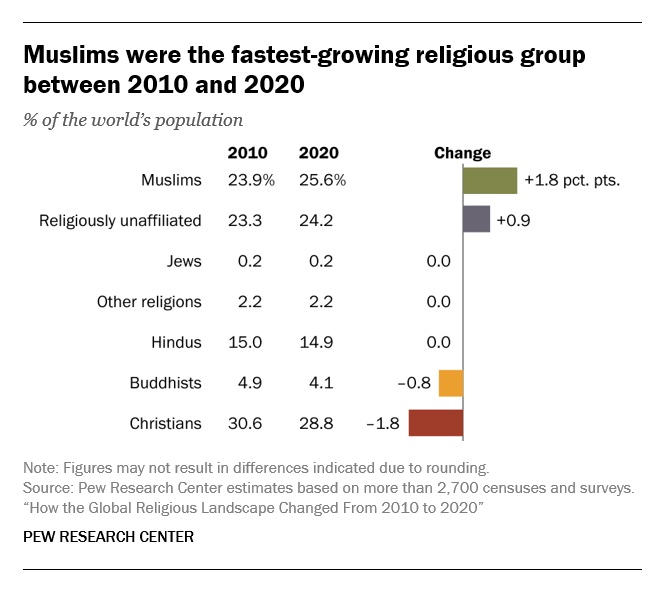
• The religiously unaffiliated population is the world’s third-largest religious category (24.2% of the global population), after Christians and Muslims. Between 2010 and 2020, religiously unaffiliated people grew more than any group except Muslims, despite their demographic disadvantages of an older age structure and relatively low fertility. The unaffiliated made up a majority of the population in 10 countries and territories in 2020, up from seven a decade earlier.
• Hindus are the fourth-largest religious category (14.9% of the world’s population), after Christians, Muslims and religiously unaffiliated people. Most (99%) live in the Asia-Pacific region; 95% of all Hindus live in India alone. Between 2010 and 2020, Hindus remained a stable share of the world’s population because their fertility resembles the global average, and surveys indicate that switching out of or into Hinduism is rare.
• Buddhists (4.1% of the world’s population) are the only group in this report whose number declined worldwide between 2010 and 2020. This was due both to religious disaffiliation among Buddhists in East Asia and to a relatively low birth rate among Buddhists, who tend to live in countries with older populations. Most of the world’s Buddhists (98%) reside in the Asia-Pacific region, the birthplace of Buddhism.
• Jews, the smallest religious group analyzed separately in this report (0.2% of the world’s population), lagged behind global population growth between 2010 and 2020 – despite having fertility rates on par with the global average – due to their older age structure. Most Jews live either in North America (primarily in the United States) or in the Middle East-North Africa region (almost exclusively in Israel).
These are among the key findings of a Pew Research Center analysis of more than 2,700 censuses and surveys, including census data releases that were delayed due to the coronavirus pandemic. This report is part of the Pew-Templeton Global Religious Futures project, which analyzes global religious change and its impact on societies around the world. Funding for the Global Religious Futures project comes from The Pew Charitable Trusts and the John Templeton Foundation.
Uncategorized
Antisemitism in some unlikely places in America

By HENRY SREBRNIK Antisemitism flourishes in a place where few might expect to confront it – medical schools and among doctors. It affects Jews, I think, more emotionally than Judeophobia in other fields.
Medicine has long been a Jewish profession with a history going back centuries. We all know the jokes about “my son – now also my daughter – the doctor.” Physicians take the Hippocratic Oath to heal the sick, regardless of their ethnicity or religion. When we are ill doctors often become the people who save us from debilitating illness and even death. So this is all the more shocking.
Yes, in earlier periods there were medical schools with quotas and hospitals who refused or limited the number of Jews they allowed to be affiliated with them. It’s why we built Jewish hospitals and practices. And of course, we all shudder at the history of Nazi doctors and euthanasia in Germany and in the concentration camps of Europe. But all this – so we thought – was a thing of a dark past. Yet now it has made a comeback, along with many other horrors we assume might never reappear.
Since the Hamas attack on Israel on October 7, 2023, there has been a resurgence of antisemitism, also noticeable in the world of healthcare. This is not just a Canadian issue. Two articles on the Jewish website Tablet, published Nov. 21, 2023, and May 18, 2025, spoke to this problem in American medicine as well, referencing a study by Ian Kingsbury and Jay P. Greene of Do No Harm, a health care advocacy group, based on data amassed by the organization Stop Antisemitism. They identified a wave of open Jew-hatred by medical professionals, medical schools, and professional associations, often driven by foreign-trained doctors importing the Jew-hatred of their native countries, suggesting “that a field entrusted with healing is becoming a licensed purveyor of hatred.”
Activists from Doctors Against Genocide, American Palestinian Women’s Association, and CODEPINK held a demonstration calling for an immediate cease-fire in Gaza at the Hart Senate Office Building in Washington, D.C., Nov. 16, 2023, almost as soon as the war began. A doctor in Tampa took to social media to post a Palestinian flag with the caption “about time!!!” The medical director of a cancer centre in Dearborn, Michigan, posted on social media: “What a beautiful morning. What a beautiful day.” Even in New York, a physician commented on Instagram that “Zionist settlers” got “a taste of their own medicine.” A Boston-based dentist was filmed ripping down posters of Israeli victims and a professor at the University of Pennsylvania Perelman School of Medicine did the same. Almost three-quarters of American medical associations felt the need to speak out on the war in Ukraine but almost three-quarters had nothing to say about the war in Israel.
Antisemitism in academic medical centres is fostering noxious environments which deprive Jewish healthcare professionals of their civil right to work in spaces free from discrimination and hate, according to a study by the Data & Analytics Department of StandWithUs, an international, non-partisan education organization that supports Israel and fights antisemitism.
“Academia today is increasingly cultivating an environment which is hostile to Jews, as well as members of other religious and ethnic groups,” StandWithUs director of data and analytics, and study co-author, Alexandra Fishman, said on May 5 in a press release. “Academic institutions should be upholding the integrity of scholarship, prioritizing civil discourse, rather than allowing bias or personal agendas to guide academic culture.”
The study, “Antisemitism in American Healthcare: The Role of Workplace Environment,” included survey data showing that 62.8 per cent of Jewish healthcare professionals employed by campus-based medical centres reported experiencing antisemitism, a far higher rate than those working in private practice and community hospitals. Fueling the rise in hate, it added, were repeated failures of DEI (diversity, equity, and inclusion) initiatives to educate workers about antisemitism, increasing, the report said, the likelihood of antisemitic activity.
“When administrators and colleagues understand what antisemitism looks like, it clearly correlates with less antisemitism in the workplace,” co-author and Yeshiva University professor Dr. Charles Auerbach reported. “Recognition is a powerful tool — institutions that foster awareness create safer, more inclusive environments for everyone.”
Last December, the Data & Analytics Department also published a study which found that nearly 40 per cent of Jewish American health-care professionals have encountered antisemitism in the workplace, either as witnesses or victims. The study included a survey of 645 Jewish health workers, a substantial number of whom said they were subject to “social and professional isolation.” The problem left more than one quarter of the survey cohort, 26.4 per cent, “feeling unsafe or threatened.”
The official journal of the Alliance for Academic Internal Medicine concurs. According to “The Moral Imperative of Countering Antisemitism in US Medicine – A Way Forward,” by Hedy S. Wald and Steven Roth, published in the October 2024 issue of the American Journal of Medicine, increased antisemitism in the United States has created a hostile learning and practice environment in medical settings. This includes instances of antisemitic behaviour and the use of antisemitic symbols at medical school commencements.
Examples of its impact upon medicine include medical students’ social media postings claiming that Jews wield disproportionate power, antisemitic slogans at the University of California, Los Angeles (UCLA) David Geffen School of Medicine, antisemitic graffiti at the University of California, San Francisco (UCSF) Cancer Centre, Jewish medical students’ exposure to demonization of Israel diatribes and rationalizing terrorism; and faculty, including a professor of medicine at UCSF, posting antisemitic tropes and derogatory comments about Jewish health care professionals. Jewish medical students’ fears of retribution, should they speak out, have been reported. “Our recent unpublished survey of Jewish physicians and trainees demonstrated a twofold increase from 40% to 88% for those who experienced antisemitism prior to vs after October 7,” they stated.
In some schools, Jewish faculty are speaking out. In February, the Jewish Faculty Resilience Group at UCLA accused the institution in an open letter of “ignoring” antisemitism at the School of Medicine, charging that its indifference to the matter “continues to encourage more antisemitism.” It added that discrimination at the medical school has caused demonstrable harm to Jewish students and faculty. Student clubs, it said, are denied recognition for arbitrary reasons; Jewish faculty whose ethnic backgrounds were previously unknown are purged from the payrolls upon being identified as Jews; and anyone who refuses to participate in anti-Zionist events is “intimidated” and pressured.
Given these findings, many American physicians are worried not only as Jewish doctors and professionals, but for Jewish patients who are more than ever concerned with whom they’re meeting. Can we really conceive of a future where you’re not sure if “the doctor will hate you now?”
Henry Srebrnik is a professor of political science at the University of Prince Edward Island.
Uncategorized
The 2025 Toronto Walk (and talk ) for Israel
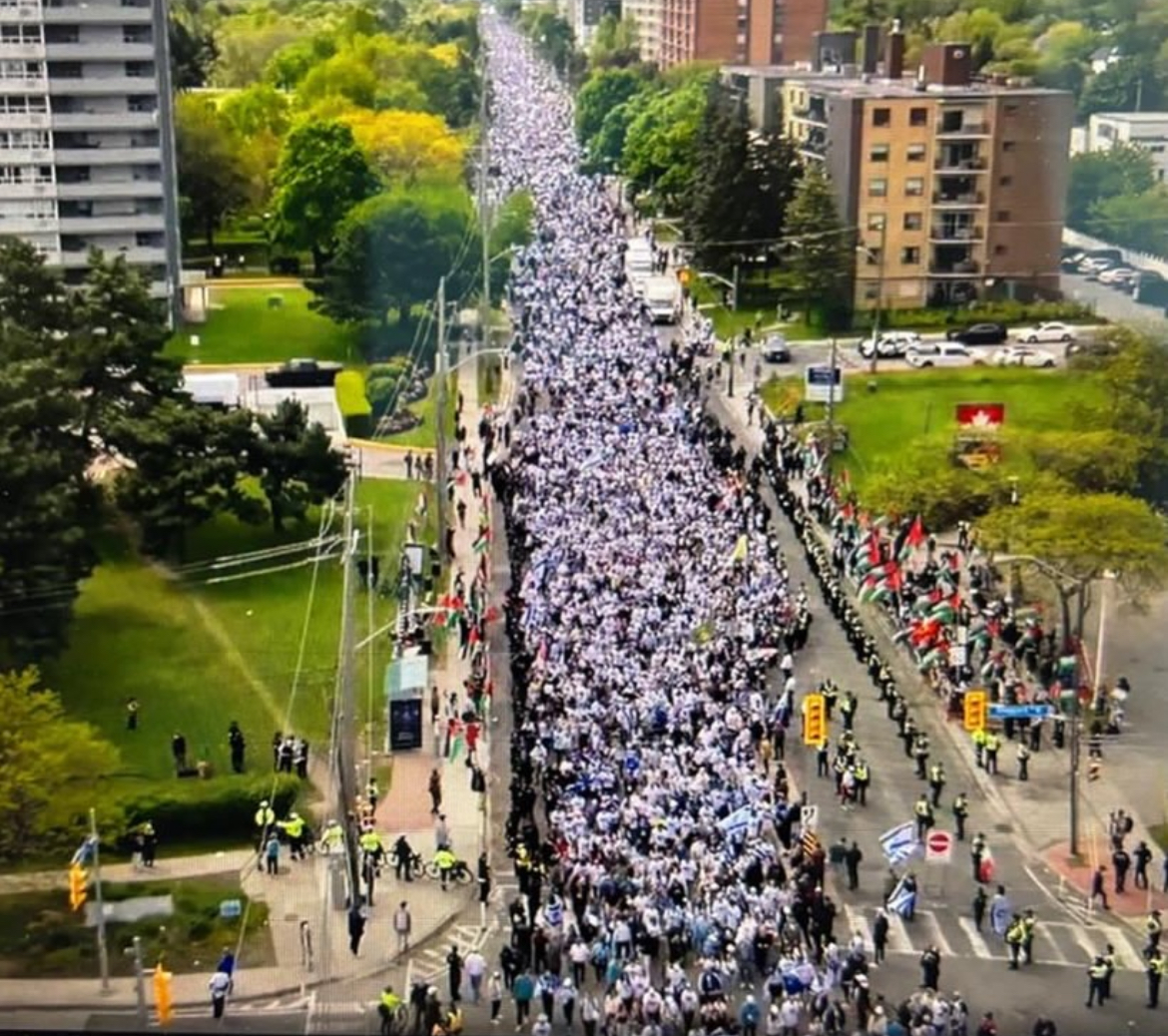
By GERRY POSNER There are walks and then there are walks. The Toronto UJA Walk for Israel on May 25, 2025 was one of a kind, at least as far as Canada and Jews are concerned. The number of people present was estimated to be 56,000 people or 112,000 total shoes. (How they get to that number is bewildering to me, since there is no one counting). This was 6,000 more than last year. Whether it is true or not, take it from me, it was packed. The synagogues in Canada should be so fortunate to get those numbers in total on High Holidays. The picture here gives you a sense of the size of the crowd.
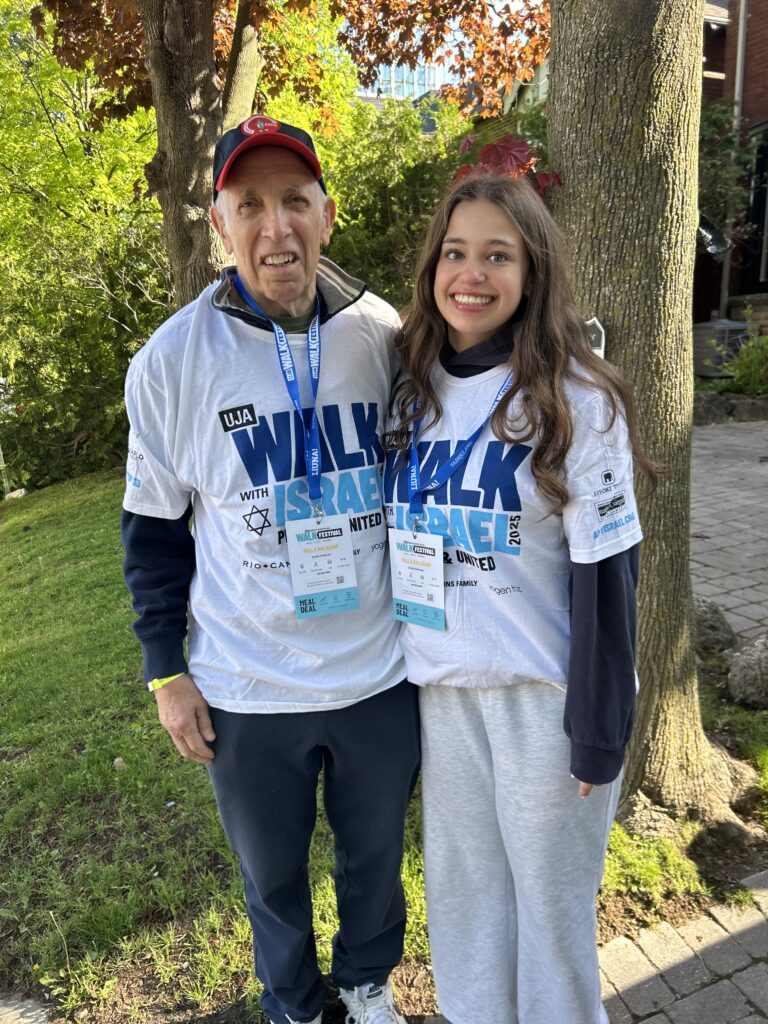
This was my first walk in Toronto for Israel and I was with my granddaughter, Samantha Pyzer (not to forget her two friends whom she managed to meet at the site, no small feat, even with iPhones as aids). The official proceedings began at 9:00 a.m. and the walk at 10:00 a.m. There was entertainment to begin with, also along the way, and at the finish as well. The finish line this year was the Prosserman Centre or the JCC as it often called. The walk itself was perhaps 4 kilometres – not very long, but the walking was slow, especially at the beginning. There were lots of strollers, even baby carriages, though I did not see any wheelchairs. All ages participated on this walk. I figured, based on what I could see on the faces of people all around me that, although I was not the oldest one on the walk, I bet I made the top 100 – more likely the top 20.
What was a highlight for me was the number of Winnipeggers I met, both past and present. Connecting with them seemed to be much like a fluke. No doubt, I missed la lot of them, but I saw, in no particular order (I could not recall the order if my life depended on it): Alta Sigesmund, (who was, a long time ago, my daughter Amira’s teacher), Marni Samphir, Karla Berbrayer and her husband Dr. Allan Kraut and family. Then, when Samantha and I made it to the end and sat down to eat, I struck up a conversation with a woman unknown to me and as we chatted, she confirmed her former Winnipeg status as a sister-in- law to David Devere, as in Betty Shwemer, the sister of Cecile Devere. I also chanced upon Terri Cherniack, only because I paused for a moment and she spotted me. As we closed in near the finish, I met ( hey were on their way back), Earl and Suzanne Golden and son Matthew, as well as Daniel Glazerman. That stop caused me to lose my granddaughter and her pals. Try finding them amid the noise and size of the crowd – but I pulled it off.
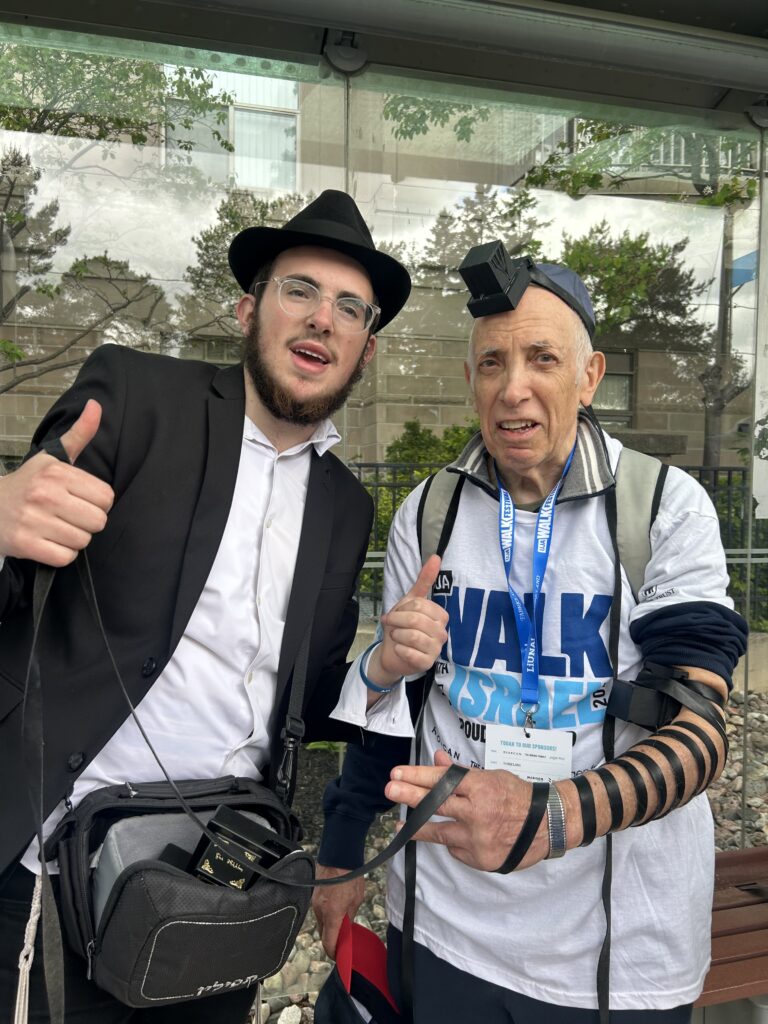
As I was in line to get food, I started chatting with a guy in the vicinity of my age. I dropped the Winnipeg link and the floodgates opened with “ Did I know Jack and Joanie Rusen?” So that was an interesting few minutes. And I was not too terribly surprised to come across some of my Pickleball family. All of these meetings, along with spotting some of my sister’s family and other cousins, were carried on with the sound of the shofar as we moved along the way. In short, this was a happening. Merchants selling a variety of products, many of them Israeli based, were in evidence and, of course, the day could not have ended without the laying of tefillin, aided by Chabad, who have perfected the procedure to take less than a minute. See the photo. Chabad had a willing audience.
Aside from the joy of sharing this experience with my granddaughter, the very presence of all these Jews gathered together for a common reason made this day very special to me. However, there was a downside to the day. The downside was that, as we began to walk back to our car there was no other way I could figure out how to return when the rains came and came. While we walked faster, we were impeded by pouring rain and puddles. But Samantha wanted to persevere, as did I. We made it, but were drenched. My runners are still drying out as I write this two days later.
What with being surrounded by 56,000 people, the noise, the slow walking, and the rain, I can still say the day was a real highlight for me – one of the better moments since our arrival in Toronto in 2012. As well as the photos we took along the way, I have the reminder of the day, courtesy of the UJA, as evidenced from the photo. It was not just the walk, but the talk that accompanied the walk that made it so worthwhile for me. I would do it again, minus the rain.
